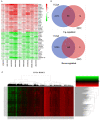Identification of a Novel Signature Predicting Overall Survival in Head and Neck Squamous Cell Carcinoma
- PMID: 34631779
- PMCID: PMC8498039
- DOI: 10.3389/fsurg.2021.717084
Identification of a Novel Signature Predicting Overall Survival in Head and Neck Squamous Cell Carcinoma
Abstract
Background: Head and neck squamous cell carcinoma (HNSCC) is a highly heterogeneous tumor with a high incidence and poor prognosis. Therefore, effective predictive models are needed to evaluate patient outcomes and optimize treatment. Methods: Robust Rank Aggregation (RRA) method was used to identify highly robust differentially-expressed genes (DEGs) between HNSCC and normal tissue in 9 GEO and TCGA datasets. Univariate Cox regression analysis and Lasso Cox regression analysis were performed to identify DEGs related to the Overall survival (OS) and to construct a prognostic gene signature (HNSCCSig). External validation was performed using GSE65858 dataset. Moreover, comprehensive bioinformatics analyses were used to identify the association between HNSCCSig and tumor immune environment. Results: A total of 257 reliable DEGs were identified by differentially analysis result of TCGA and GSE65858 datasets. The HNSCCSig including 7 mRNAs (SLURP1, SCARA5, CLDN10, MYH11, CXCL13, HLF, and ITGA3) were developed and validated to identify high-risk group who had a worse OS than low-risk group in TCGA and GSE65858 datasets. Cox regression analysis showed that the HNSCCSig could independently predict OS in both the TCGA and the GSE65858 datasets. Further research demonstrated that the infiltration bundance of CD8 + T cells, B cells, neutrophils, and NK cells were significantly lower in the high-risk group. A nomogram was also constructed by combining the HNSCCSig and clinical characters. Conclusion: We established and validated the HNSCCSig consisting of SLURP1, SCARA5, CLDN10, MYH11, CXCL13, HLF, and ITGA3. A nomogram combining HNSCCSig and some clinical parameters was constructed to identify high-risk HNSCC-patients with poor prognosis.
Keywords: head and neck squamous cell carcinoma (HNSCC); nomogram; overall survival (OS); robust rank aggregation method; signature.
Copyright © 2021 Zheng, Liu, Lu and Li.
Conflict of interest statement
The authors declare that the research was conducted in the absence of any commercial or financial relationships that could be construed as a potential conflict of interest.
Figures








Similar articles
-
A model of seven immune checkpoint-related genes predicting overall survival for head and neck squamous cell carcinoma.Eur Arch Otorhinolaryngol. 2021 Sep;278(9):3467-3477. doi: 10.1007/s00405-020-06540-4. Epub 2021 Jan 15. Eur Arch Otorhinolaryngol. 2021. PMID: 33449165
-
Prognostic Value of Eight-Gene Signature in Head and Neck Squamous Carcinoma.Front Oncol. 2021 Jun 18;11:657002. doi: 10.3389/fonc.2021.657002. eCollection 2021. Front Oncol. 2021. PMID: 34221975 Free PMC article.
-
Nine-gene signature and nomogram for predicting survival in patients with head and neck squamous cell carcinoma.Front Genet. 2022 Aug 24;13:927614. doi: 10.3389/fgene.2022.927614. eCollection 2022. Front Genet. 2022. PMID: 36092911 Free PMC article.
-
Development and validation of a fourteen- innate immunity-related gene pairs signature for predicting prognosis head and neck squamous cell carcinoma.BMC Cancer. 2020 Oct 20;20(1):1015. doi: 10.1186/s12885-020-07489-7. BMC Cancer. 2020. PMID: 33081731 Free PMC article.
-
Development and Validation of a Prognostic Signature Based on the Lysine Crotonylation Regulators in Head and Neck Squamous Cell Carcinoma.Biomed Res Int. 2023 Feb 13;2023:4444869. doi: 10.1155/2023/4444869. eCollection 2023. Biomed Res Int. 2023. PMID: 36814797 Free PMC article.
Cited by
-
Deciphering the tumor immune microenvironment: single-cell and spatial transcriptomic insights into cervical cancer fibroblasts.J Exp Clin Cancer Res. 2025 Jul 5;44(1):194. doi: 10.1186/s13046-025-03432-5. J Exp Clin Cancer Res. 2025. PMID: 40616092 Free PMC article.
-
Evaluation of Integrin Glycovariants as Biomarkers of Metastasis, Invasion, and Therapy Stratification in Head and Neck Squamous Cell Carcinoma.Cancer Med. 2025 May;14(9):e70717. doi: 10.1002/cam4.70717. Cancer Med. 2025. PMID: 40287842 Free PMC article.
-
Seven Immune-Related Genes' Prognostic Value and Correlation with Treatment Outcome in Head and Neck Squamous Cell Carcinoma.Mediators Inflamm. 2023 Apr 20;2023:8533476. doi: 10.1155/2023/8533476. eCollection 2023. Mediators Inflamm. 2023. PMID: 39282247 Free PMC article.
-
Transcriptomics data mining to uncover signature genes in head and neck squamous cell carcinoma: a bioinformatics analysis and RNA-sequencing based validation.Am J Cancer Res. 2023 Nov 15;13(11):5513-5530. eCollection 2023. Am J Cancer Res. 2023. PMID: 38058845 Free PMC article.
-
The survival rate of laryngeal squamous cell carcinoma: impact of IL1RAP rs4624606, IL1RL1 rs1041973, IL-6 rs1800795, BLK rs13277113, and TIMP3 rs9621532 single nucleotide polymorphisms.Discov Oncol. 2023 Jan 22;14(1):8. doi: 10.1007/s12672-023-00619-0. Discov Oncol. 2023. PMID: 36682035 Free PMC article.
References
LinkOut - more resources
Full Text Sources
Research Materials

